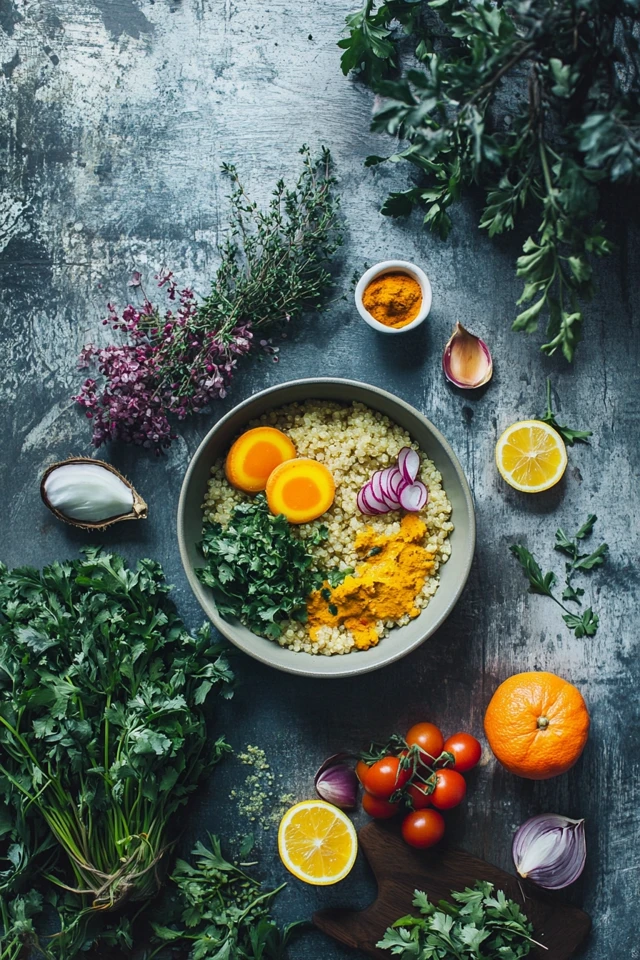Introduction
In the quest for delicious, nutritious, and easy-to-make vegan meals, the One-Pot Coconut Curry Quinoa stands out as a true gem. This dish combines the rich, creamy flavors of coconut milk with the hearty goodness of quinoa and the vibrant spices of curry, creating a meal that’s both comforting and nourishing. Perfect for busy weeknights or when you crave something warm and satisfying, this one-pot wonder simplifies your cooking process without compromising on taste or health benefits.
Whether you’re a seasoned vegan, exploring plant-based eating, or simply looking to diversify your meal repertoire, this recipe offers a perfect balance of flavors, textures, and nutrients. In this comprehensive guide, we’ll explore the benefits of this dish, walk you through each step of the preparation, and share tips and variations to make it your own. Let’s dive into creating a creamy and comforting vegan meal that will delight your taste buds and nourish your body.
Why Choose a One-Pot Coconut Curry Quinoa?
The One-Pot Coconut Curry Quinoa is more than just a meal; it’s a celebration of plant-based cooking that brings together simplicity, nutrition, and incredible flavor. Here’s why this dish should be a staple in your vegan kitchen:
Nutritional Powerhouse
- Quinoa: Often referred to as a superfood, quinoa is a complete protein containing all nine essential amino acids. It’s also rich in fiber, magnesium, B vitamins, iron, potassium, calcium, phosphorus, vitamin E, and various beneficial antioxidants.
- Coconut Milk: Provides healthy fats that promote satiety and support brain health. Coconut milk adds a creamy texture and rich flavor to the dish while contributing essential fatty acids.
- Vegetables: A mix of colorful vegetables like bell peppers, carrots, and spinach ensures a wide range of vitamins, minerals, and antioxidants, enhancing the meal’s nutritional profile.
- Spices: Curry powder, turmeric, and cumin not only infuse the dish with robust flavors but also offer anti-inflammatory and immune-boosting properties.
Convenience and Efficiency
One-pot meals are the epitome of kitchen efficiency. By cooking everything in a single pot, you minimize the number of dishes to wash and streamline the cooking process. This is especially beneficial for those with busy schedules who still want to enjoy a home-cooked, wholesome meal without spending too much time in the kitchen.
Versatility and Customization
This recipe serves as a versatile base that can be easily customized to suit your taste preferences or dietary needs. Whether you prefer a spicier curry, want to add more vegetables, or need to incorporate additional protein sources, the One-Pot Coconut Curry Quinoa can be tailored to meet your individual requirements.
Budget-Friendly
The ingredients used in this dish are not only nutritious but also affordable and widely available. Quinoa, canned coconut milk, and a variety of vegetables can be found in most grocery stores, making this meal an economical choice for nutritious eating.
Ingredients
Creating a delightful One-Pot Coconut Curry Quinoa requires a harmonious blend of fresh ingredients and aromatic spices. Here’s what you’ll need:
- 1 cup quinoa, rinsed
- 1 can (14 oz) coconut milk
- 2 cups vegetable broth (low-sodium preferred)
- 1 medium onion, diced
- 2 cloves garlic, minced
- 1-inch piece ginger, grated
- 1 red bell pepper, sliced into thin strips
- 1 yellow bell pepper, sliced into thin strips
- 2 medium carrots, diced
- 2 cups fresh spinach, washed and trimmed
- 2 tablespoons curry powder
- 1 teaspoon ground cumin
- 1 teaspoon turmeric powder
- 1/2 teaspoon paprika
- 1/2 teaspoon salt, or to taste
- 1/4 teaspoon black pepper
- 1 tablespoon olive oil or coconut oil
- Juice of 1 lime
- Fresh cilantro, chopped (optional, for garnish)
- Cooked chickpeas or tofu, for added protein (optional)
Ingredient Breakdown
- Quinoa: Serves as the primary carbohydrate source, providing a hearty and satisfying base.
- Coconut Milk: Adds creaminess and richness, balancing the spices and enhancing the overall flavor.
- Vegetable Broth: Infuses the dish with savory notes, elevating the taste profile.
- Onion, Garlic, and Ginger: Form the aromatic foundation, contributing depth and complexity to the curry.
- Bell Peppers and Carrots: Introduce vibrant colors, textures, and a range of nutrients.
- Spinach: Adds a boost of vitamins and minerals while incorporating a tender texture that blends seamlessly into the curry.
- Spices (Curry Powder, Cumin, Turmeric, Paprika): These spices not only flavor the dish but also offer numerous health benefits, including anti-inflammatory properties.
- Olive or Coconut Oil: Used for sautéing, providing a subtle flavor that complements the spices.
- Lime Juice: Adds a fresh, tangy brightness that lifts the flavors of the curry.
- Cilantro: Offers a fresh, herbal finish that enhances the overall presentation and taste.
- Chickpeas or Tofu (Optional): For those looking to increase the protein content, adding chickpeas or tofu makes the dish even more satisfying.
Instructions
Preparing the One-Pot Coconut Curry Quinoa is simple and straightforward. Follow these step-by-step instructions to create a creamy and comforting vegan meal in under 30 minutes.
Step 1: Prepare Your Ingredients
Begin by gathering and preparing all your ingredients. Proper preparation ensures a smooth cooking process.
- Quinoa: Rinse the quinoa thoroughly under cold water using a fine-mesh strainer. This removes any bitterness from the natural coating called saponin.
- Vegetables: Dice the onion, mince the garlic, grate the ginger, slice the bell peppers, and dice the carrots. Wash and trim the spinach leaves, setting them aside for later use.
Step 2: Heat the Oil and Sauté Aromatics
In a large pot or Dutch oven, heat the olive oil or coconut oil over medium heat.
- Add Onion: Once the oil is hot, add the diced onion. Sauté for about 3-4 minutes until the onions become translucent and start to soften.
- Add Garlic and Ginger: Stir in the minced garlic and grated ginger. Sauté for an additional 1-2 minutes until the mixture becomes fragrant. Be careful not to let the garlic burn, as it can impart a bitter taste to the dish.
Step 3: Add the Spices
Incorporate the spices to build the flavorful base of the curry.
- Curry Powder: Sprinkle in the curry powder, stirring constantly to prevent it from sticking to the pot. Cook for about 1 minute to release the spices’ essential oils and deepen their flavors.
- Ground Cumin, Turmeric, and Paprika: Add the ground cumin, turmeric powder, and paprika. Stir well to ensure the spices are evenly distributed and toasted lightly.
Step 4: Cook the Vegetables
Add the sliced bell peppers and diced carrots to the pot.
- Sauté Vegetables: Cook the vegetables for about 5 minutes, stirring frequently. The peppers should begin to soften while retaining some of their crispness, and the carrots should become tender yet firm.
Step 5: Incorporate Quinoa, Coconut Milk, and Broth
Bring everything together for a hearty, one-pot meal.
- Add Quinoa: Pour the rinsed quinoa into the pot, stirring to combine it with the vegetables and spices.
- Pour in Liquids: Add the can of coconut milk and the vegetable broth. Stir well to ensure all ingredients are evenly moistened and the quinoa is submerged in the liquid.
- Season: Add salt and black pepper to taste. Stir again to distribute the seasoning throughout the mixture.
Step 6: Simmer the Curry
Allow the curry to cook until the quinoa is tender and has absorbed most of the liquid.
- Bring to a Boil: Increase the heat to bring the mixture to a boil.
- Reduce Heat and Cover: Once boiling, reduce the heat to low, cover the pot with a lid, and let it simmer for about 15 minutes. Avoid lifting the lid frequently, as this can disrupt the cooking process.
- Check for Doneness: After 15 minutes, check the quinoa for tenderness. If it’s still slightly firm and there’s excess liquid, continue to simmer for an additional 5 minutes, uncovered, to allow the quinoa to fully cook and the liquid to reduce.
Step 7: Add Spinach and Lime Juice
Enhance the dish with fresh greens and a hint of citrus.
- Add Spinach: Stir in the fresh spinach leaves, one handful at a time. The spinach will wilt quickly, integrating seamlessly into the curry. Continue to stir until all the spinach is fully incorporated and wilted.
- Add Lime Juice: Squeeze the juice of one lime into the curry, stirring well to distribute the tangy brightness throughout the dish. This step adds a fresh, vibrant contrast to the rich coconut and spices.
Step 8: Serve and Garnish
Finalize your meal with delightful garnishes that elevate both flavor and presentation.
- Serve: Ladle the coconut curry quinoa into bowls, ensuring each serving is generously portioned with the creamy curry and vibrant vegetables.
- Garnish: Sprinkle freshly chopped cilantro over each bowl for a burst of herbal freshness. Serve with additional lime wedges on the side for those who prefer an extra squeeze of citrus.
- Optional Additions: For added protein and texture, top with cooked chickpeas or cubes of crispy tofu. A sprinkle of toasted sesame seeds or a drizzle of tahini can also enhance the dish’s complexity and richness.
Tips and Variations
The One-Pot Coconut Curry Quinoa is highly adaptable, allowing you to tailor it to your taste preferences and dietary needs. Here are some tips and variations to inspire your culinary creativity:
1. Enhance with Additional Vegetables
Boost the nutritional value and texture by incorporating more vegetables:
- Broccoli Florets: Add in the last 5 minutes of simmering for a crunchy bite.
- Snap Peas: Stir them in during the final few minutes to maintain their crispness.
- Sweet Potatoes: Dice and add earlier in the cooking process for a sweet contrast.
2. Increase the Protein Content
Make your meal even more satisfying by adding extra protein:
- Tofu: Press and cube firm tofu, then sauté separately until golden before adding to the curry.
- Tempeh: Slice tempeh thinly and marinate it in soy sauce and spices before adding.
- Edamame: Incorporate shelled edamame in the final minutes for an additional protein boost.
3. Adjust the Spice Level
Customize the heat to suit your preference:
- Increase Red Pepper Flakes: Add more for a spicier kick.
- Fresh Chilies: Slice jalapeños or serrano peppers and add them during the sautéing of aromatics.
- Hot Sauce: Drizzle your favorite hot sauce over the finished dish for added heat.
4. Make It Creamier
For an even richer texture, consider these additions:
- Tahini: Stir in a tablespoon of tahini towards the end of cooking for a nutty creaminess.
- Cashew Cream: Blend soaked cashews with water until smooth and mix into the curry.
- Coconut Cream: Use coconut cream instead of coconut milk for an extra creamy consistency.
5. Serve with Alternative Bases
While quinoa and brown rice are excellent options, try these alternatives:
- Cauliflower Rice: For a low-carb option, serve the curry over cauliflower rice.
- Millet or Farro: Substitute with other whole grains for varied textures and flavors.
- Whole Wheat Naan: Pair with vegan naan for a more substantial meal.
6. Incorporate Herbs and Spices
Experiment with different herbs and spices to create unique flavor profiles:
- Cilantro vs. Parsley: Swap cilantro for parsley if you prefer a milder herb.
- Garam Masala: Add a teaspoon of garam masala for an additional layer of complexity.
- Lemongrass: Infuse with lemongrass for a fragrant twist.
7. Storage and Reheating
This dish stores well, making it perfect for meal prep:
- Refrigeration: Store in airtight containers in the refrigerator for up to 4 days.
- Freezing: Freeze in portioned containers for up to 2 months. Thaw in the refrigerator overnight before reheating.
- Reheating: Reheat on the stovetop over low heat, adding a splash of vegetable broth or water to restore moisture if needed.
8. Boost with Nutritional Yeast
For a cheesy, umami flavor and an extra nutritional boost:
- Nutritional Yeast: Sprinkle 2 tablespoons into the curry while it’s simmering to enhance the flavor and increase B-vitamin content.
Nutritional Information
Understanding the nutritional profile of your meals helps you make informed dietary choices. Here’s the approximate nutritional breakdown for one serving of the One-Pot Coconut Curry Quinoa (serves 4):
Per Serving:
- Calories: 450 kcal
- Protein: 14g
- Carbohydrates: 60g
- Fiber: 10g
- Fat: 16g
- Saturated Fat: 9g
- Sugar: 8g
- Sodium: 750mg
Nutritional Highlights:
- Protein: Quinoa and chickpeas provide a substantial amount of plant-based protein, essential for muscle repair and overall body function.
- Fiber: High fiber content aids in digestion, promotes satiety, and helps maintain healthy blood sugar levels.
- Healthy Fats: Coconut milk offers medium-chain triglycerides (MCTs), which are beneficial for energy and metabolism.
- Vitamins and Minerals: Spinach and bell peppers contribute a wealth of vitamins A, C, and K, as well as essential minerals like iron and potassium.
- Antioxidants: Turmeric and ginger are rich in antioxidants, which help combat inflammation and support immune health.
Adjusting Nutritional Content:
- Lowering Calories: Reduce the amount of coconut milk or serve over a smaller portion of quinoa.
- Increasing Protein: Add more chickpeas, tofu, or a sprinkle of hemp seeds.
- Reducing Sodium: Use low-sodium vegetable broth and tamari to control the sodium content.
Conclusion
The One-Pot Coconut Curry Quinoa is a testament to the beauty of plant-based cooking—simple, nutritious, and incredibly flavorful. Its creamy texture, combined with the robust spices and vibrant vegetables, creates a meal that’s both comforting and satisfying. Whether you’re new to veganism or a seasoned plant-based enthusiast, this curry offers a versatile and delicious option that fits seamlessly into any meal plan.
By leveraging the wholesome goodness of quinoa and chickpeas, enhanced by the rich flavors of coconut milk and curry spices, this dish provides a balanced and nourishing meal that supports your health and well-being. The convenience of a one-pot meal ensures that you can enjoy a homemade, wholesome dinner without the stress of multiple cooking steps or excessive cleanup.
Moreover, the adaptability of this recipe allows you to experiment and personalize it according to your taste preferences and dietary needs. From adjusting the spice levels to incorporating additional vegetables or proteins, the One-Pot Coconut Curry Quinoa is a flexible dish that can be tailored to suit your culinary desires.
Embrace the warmth and richness of this creamy curry, and let it inspire you to explore the endless possibilities of plant-based cooking. Whether you’re serving it for yourself, your family, or your friends, this comforting vegan meal is sure to delight and nourish everyone at the table.
Picture Gallery
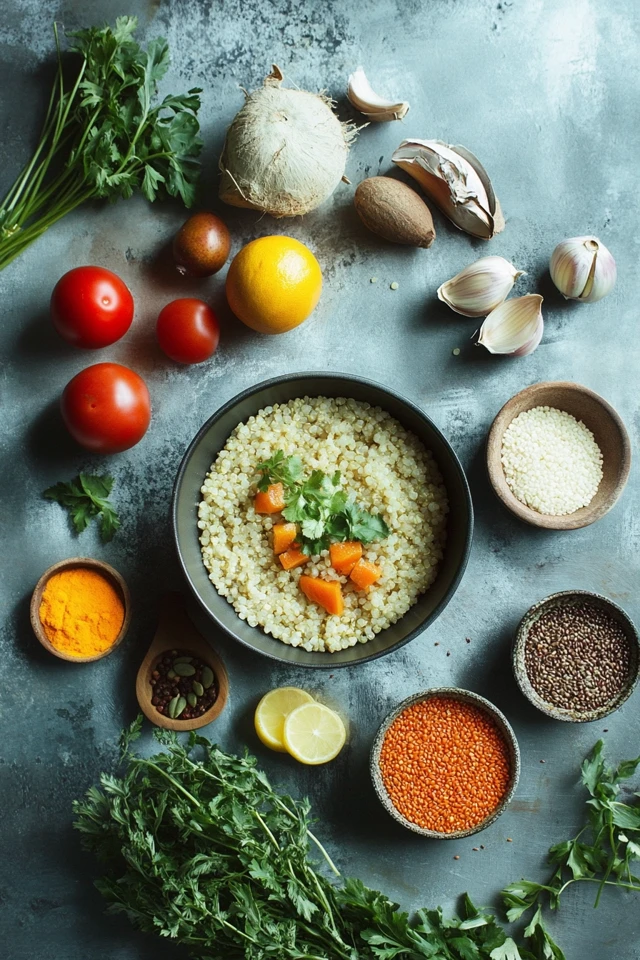
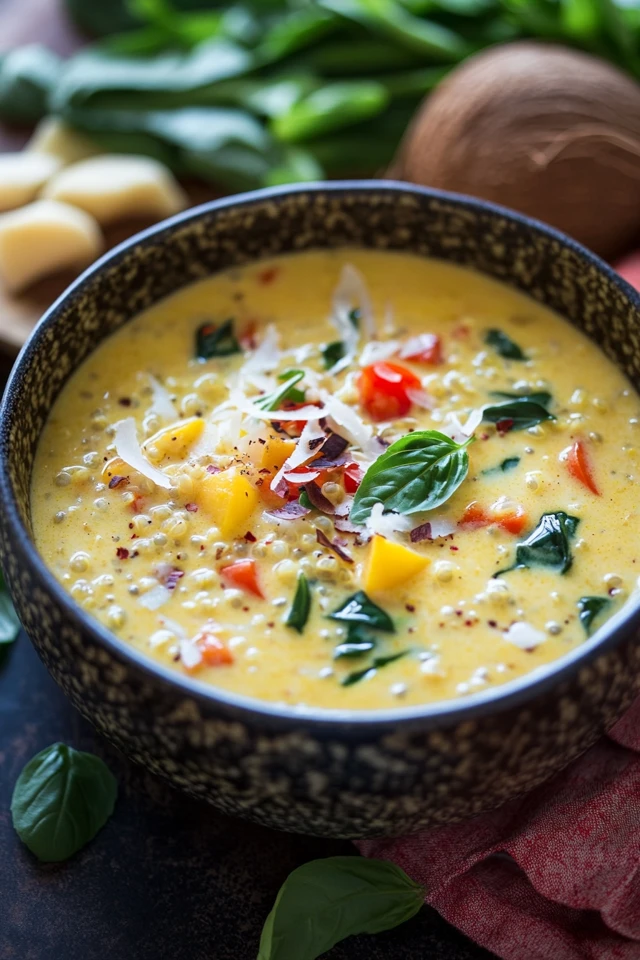
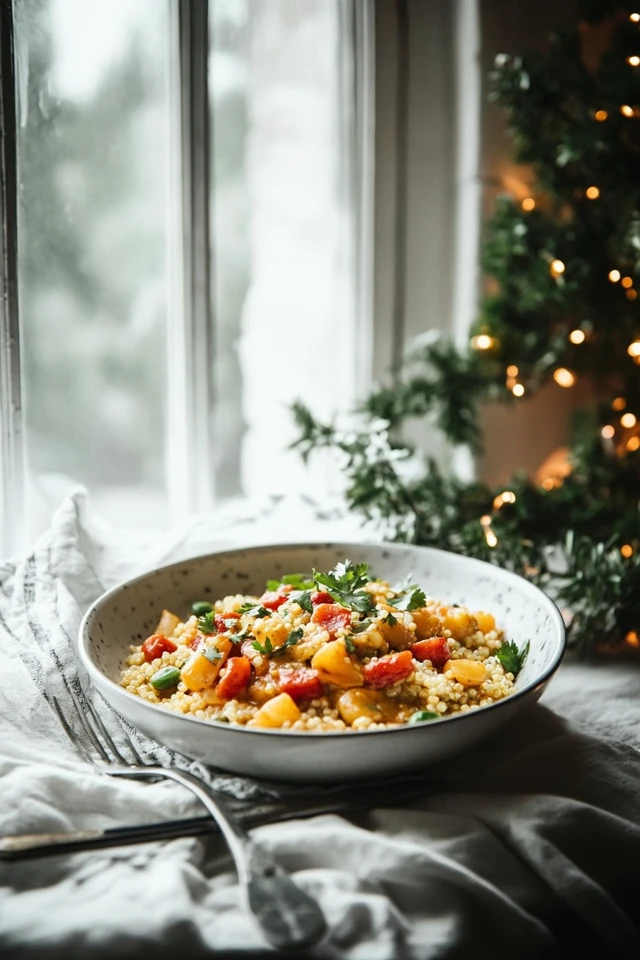
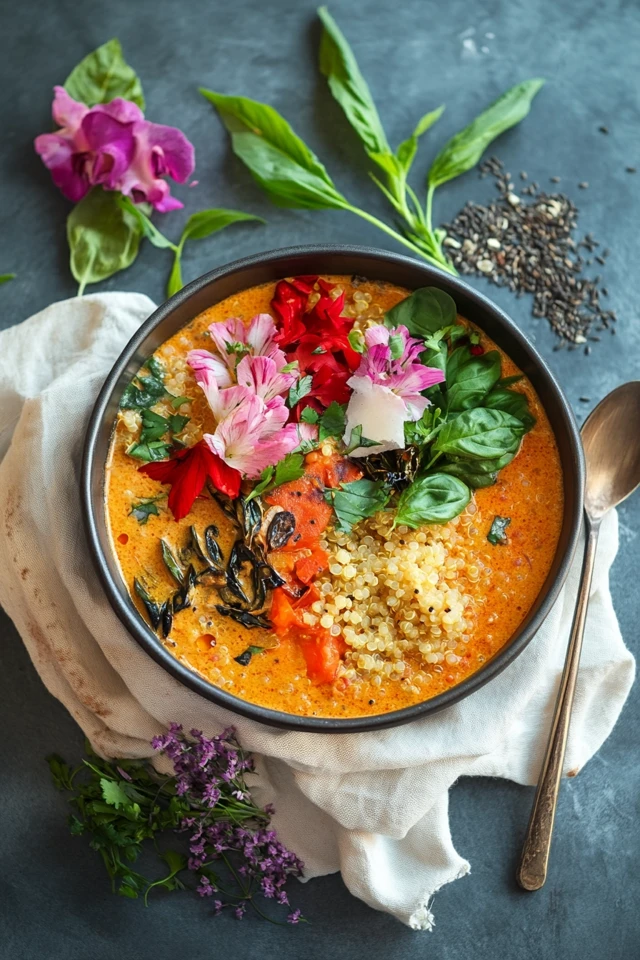
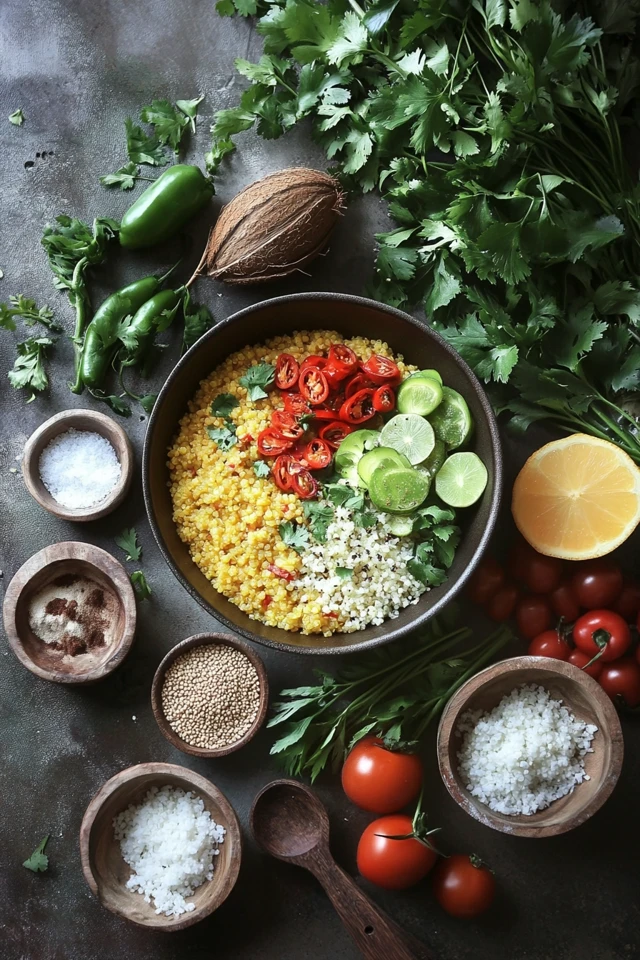
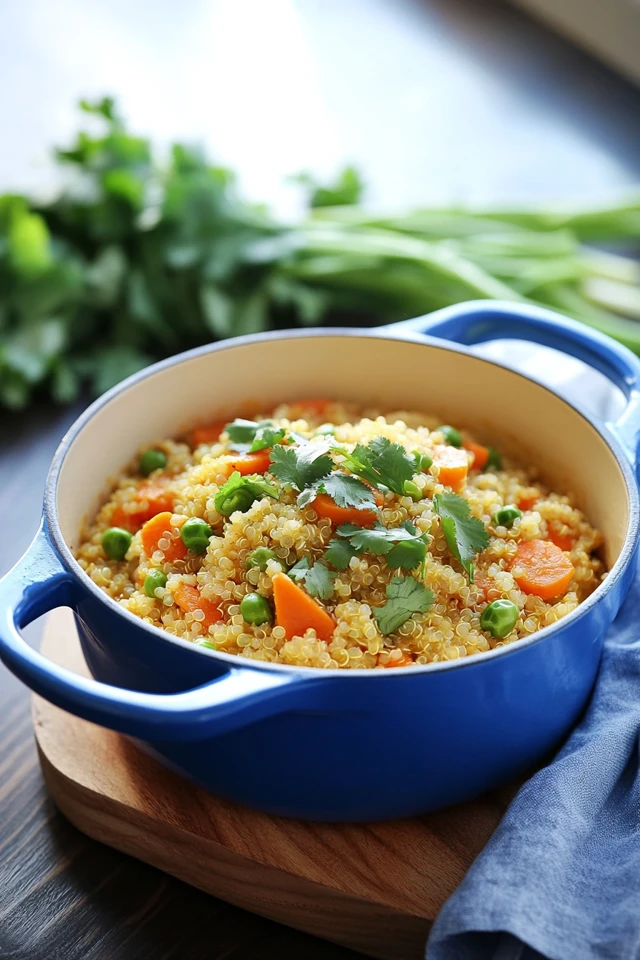
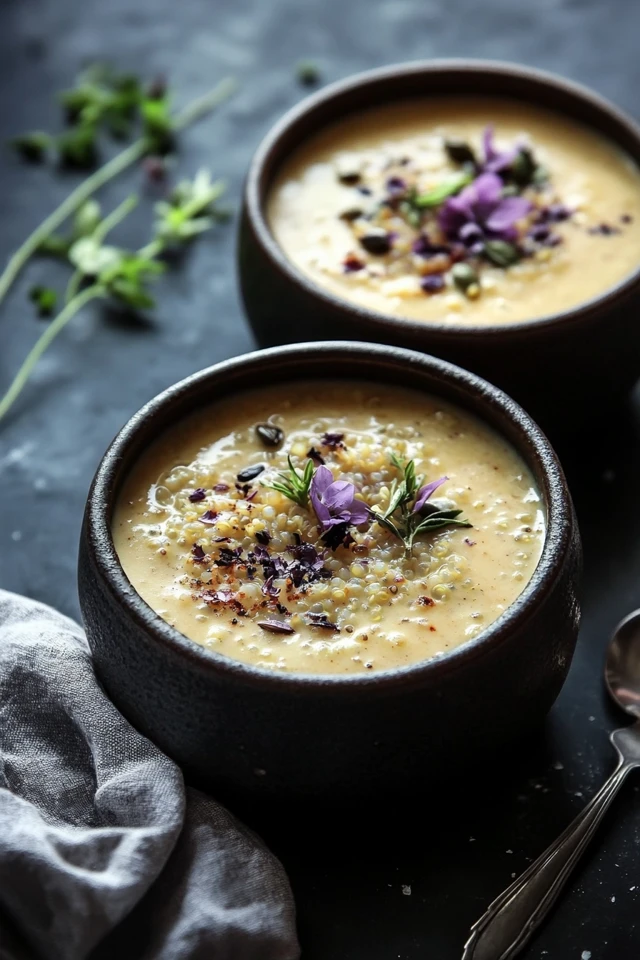
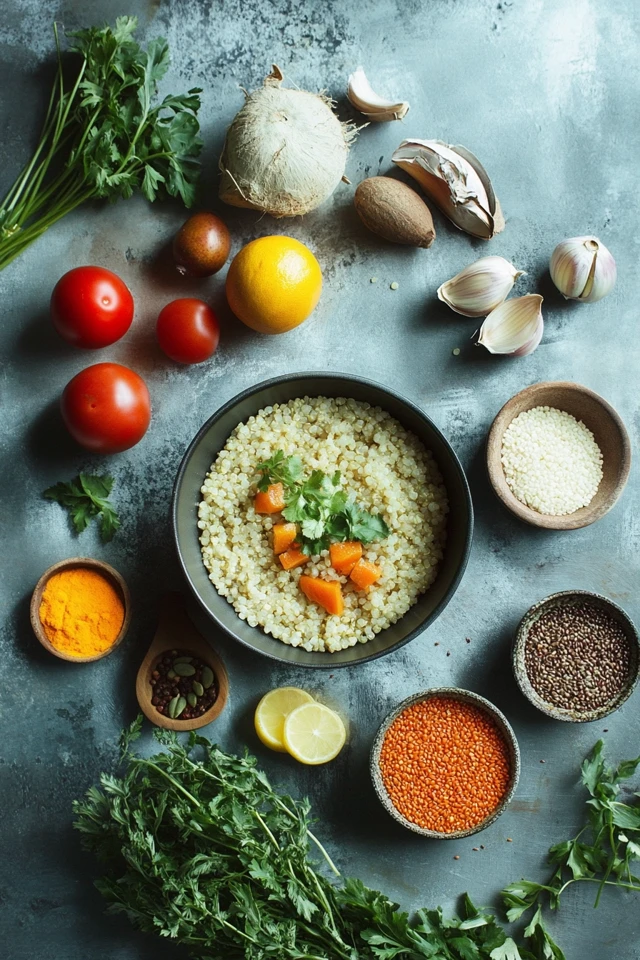
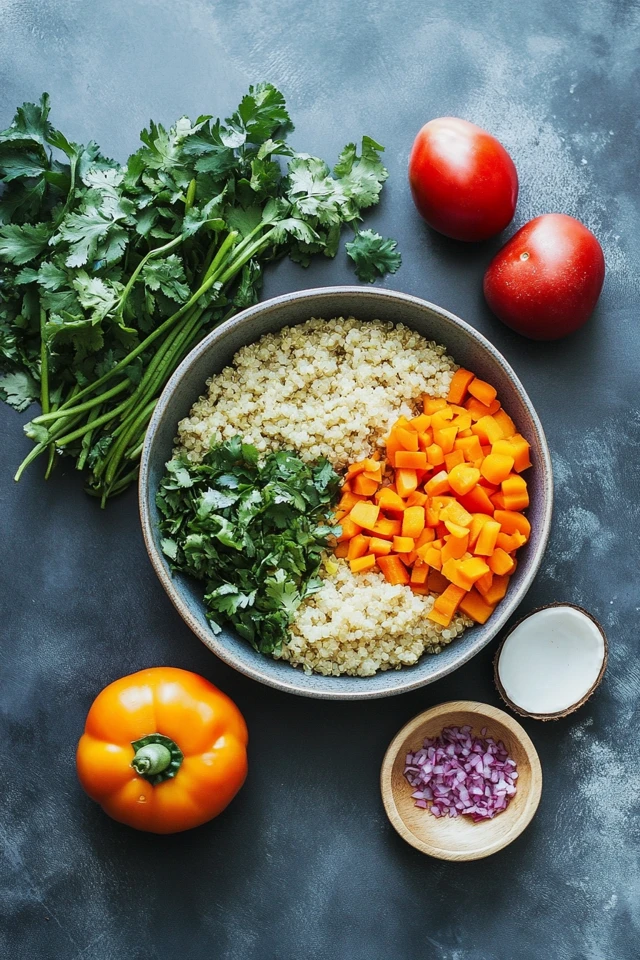
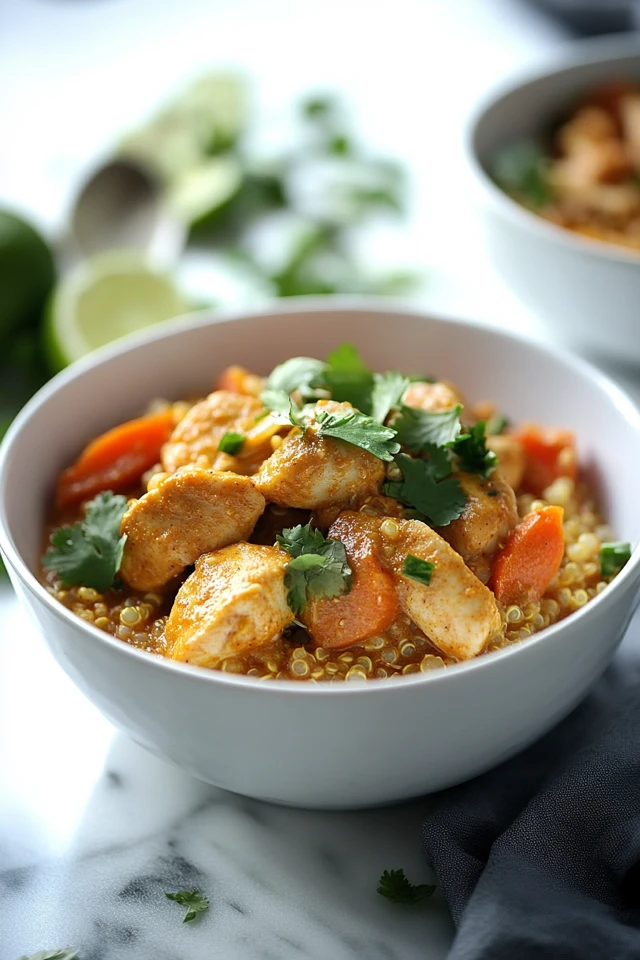
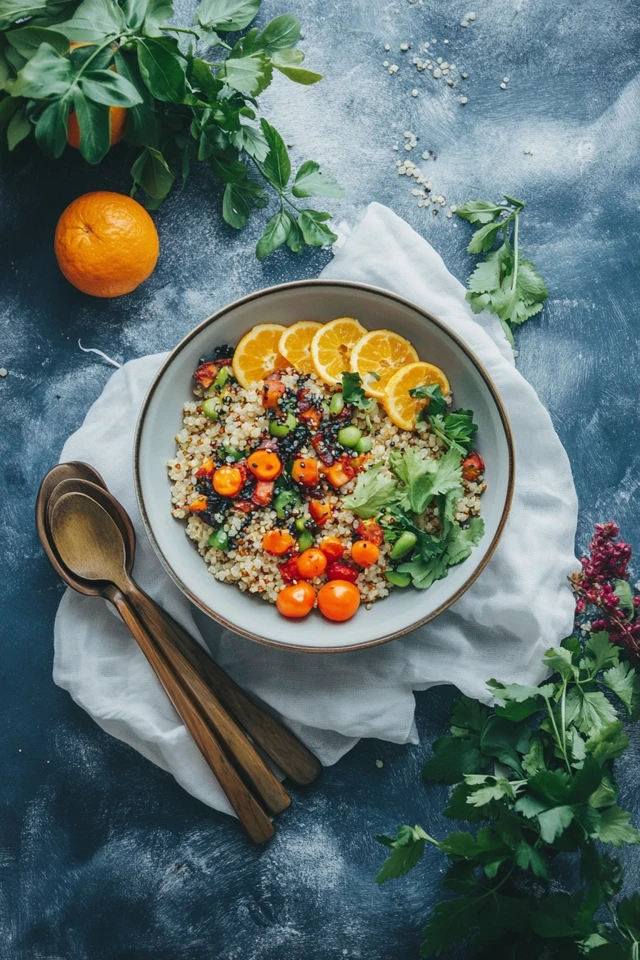
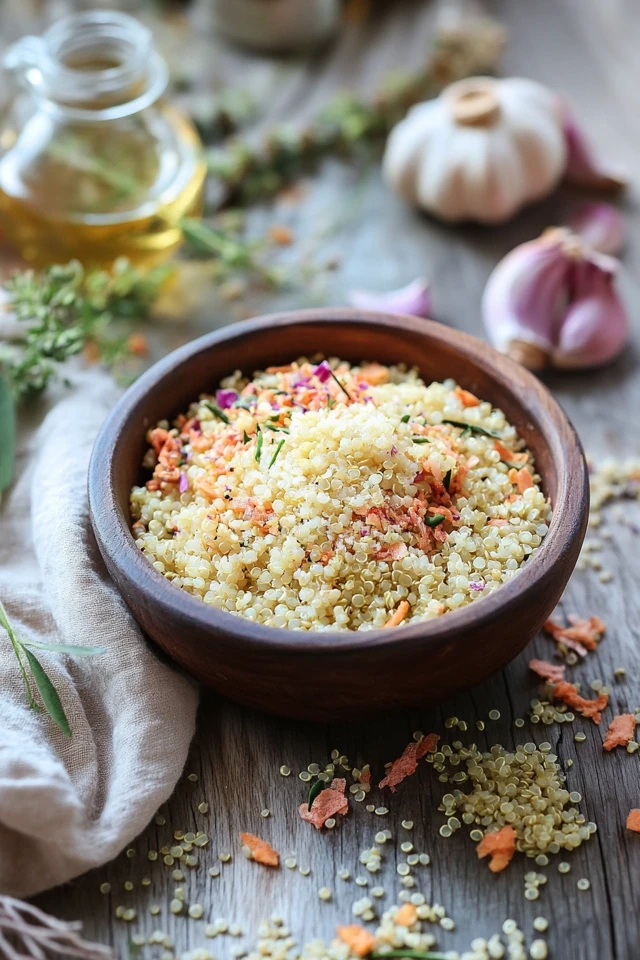
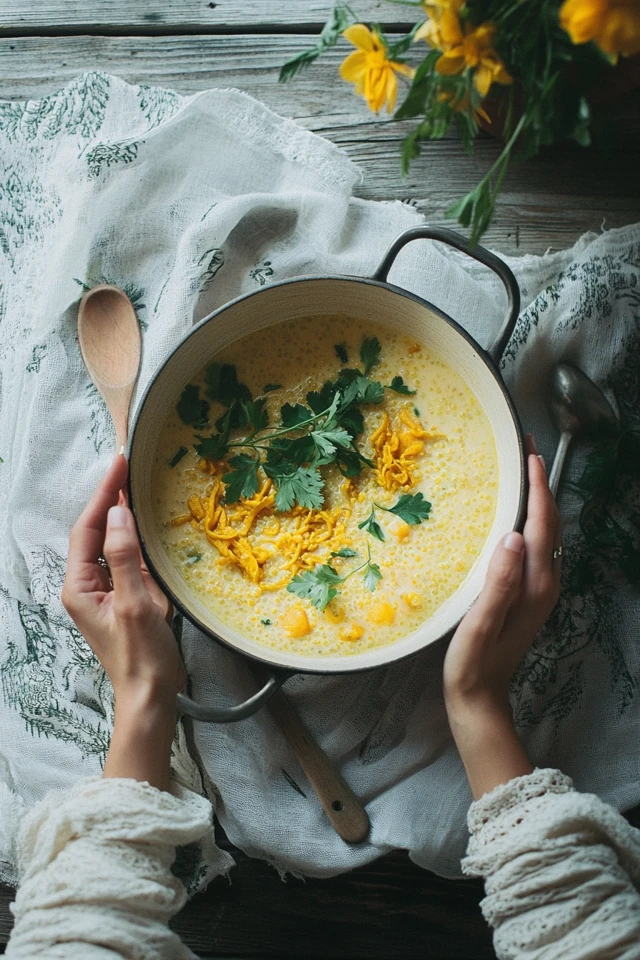
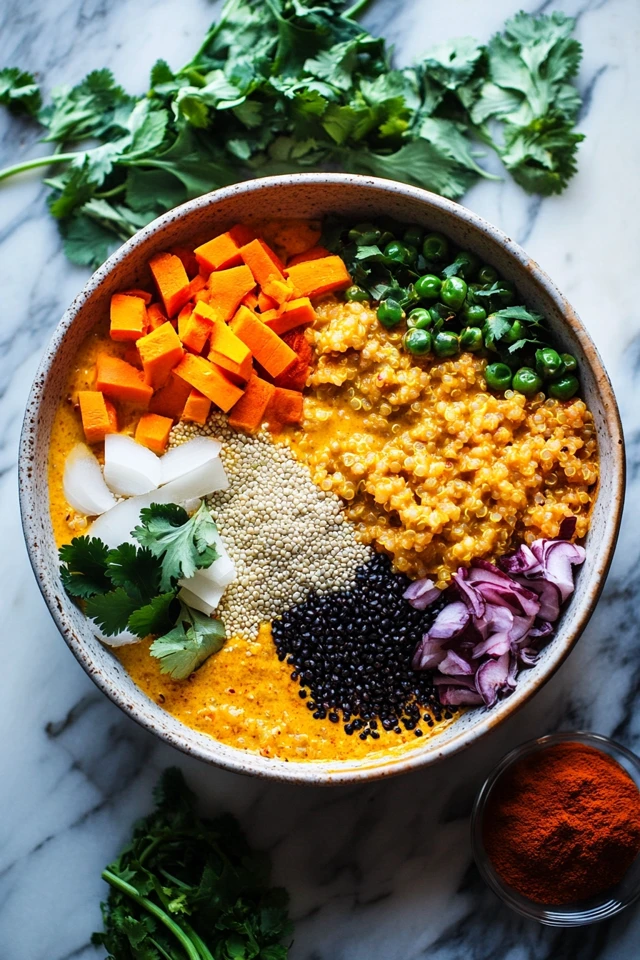
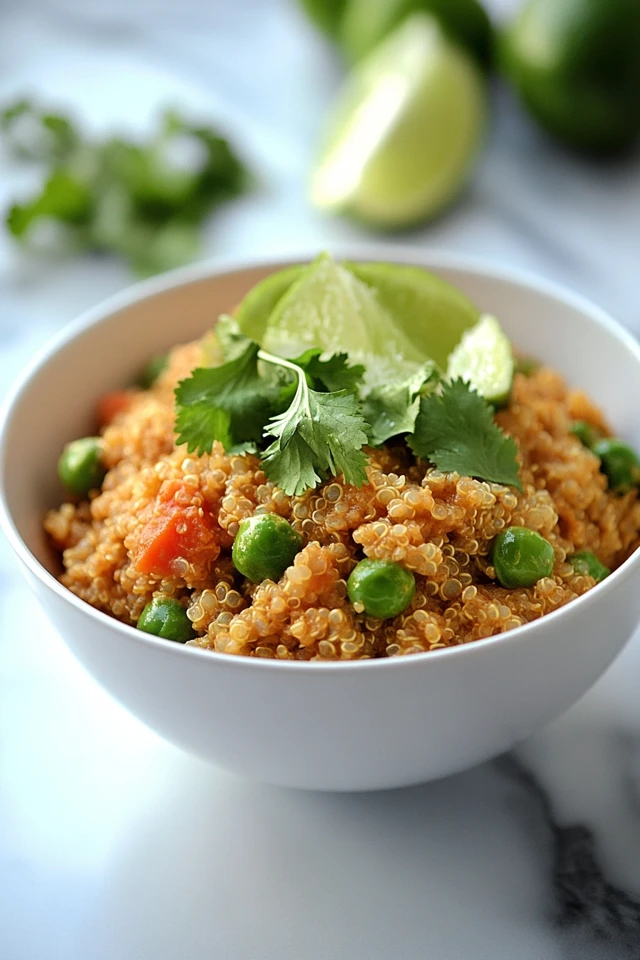
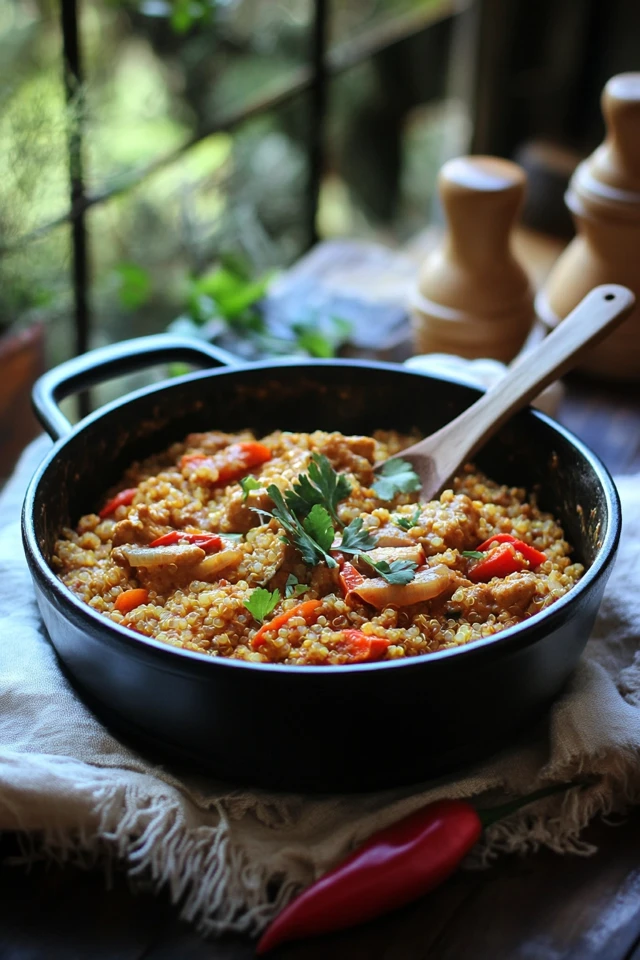

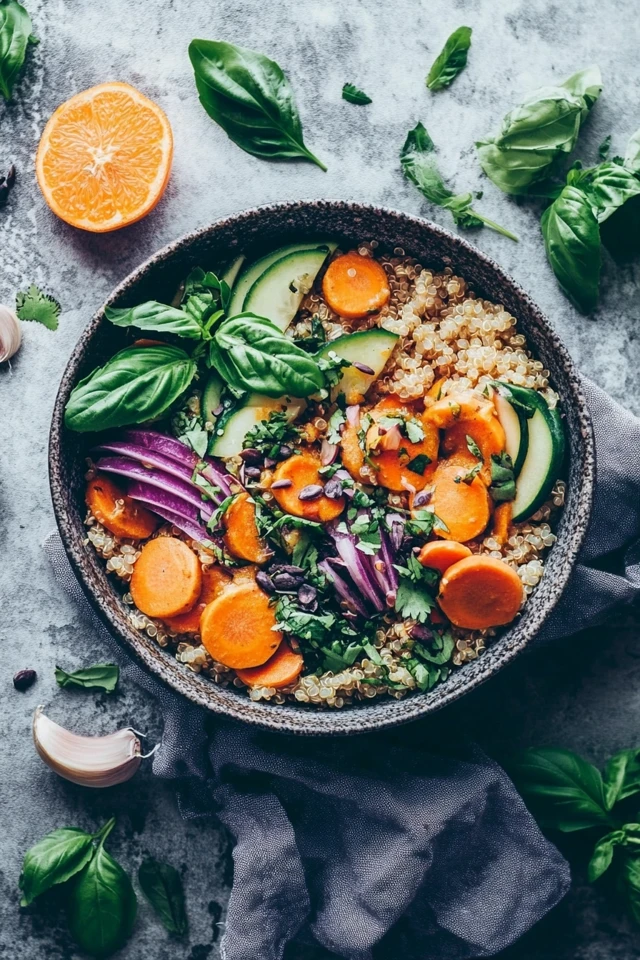
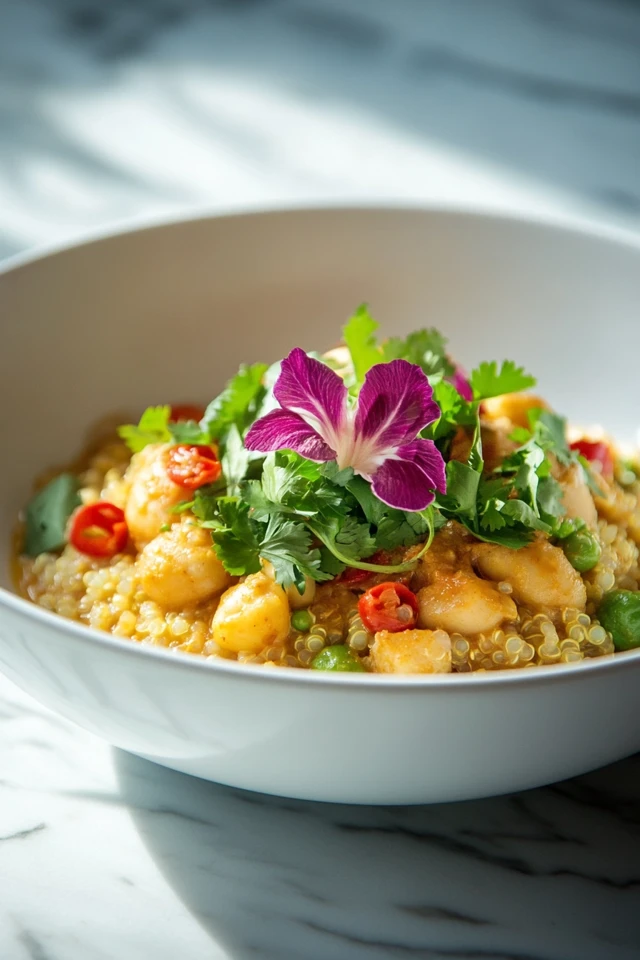
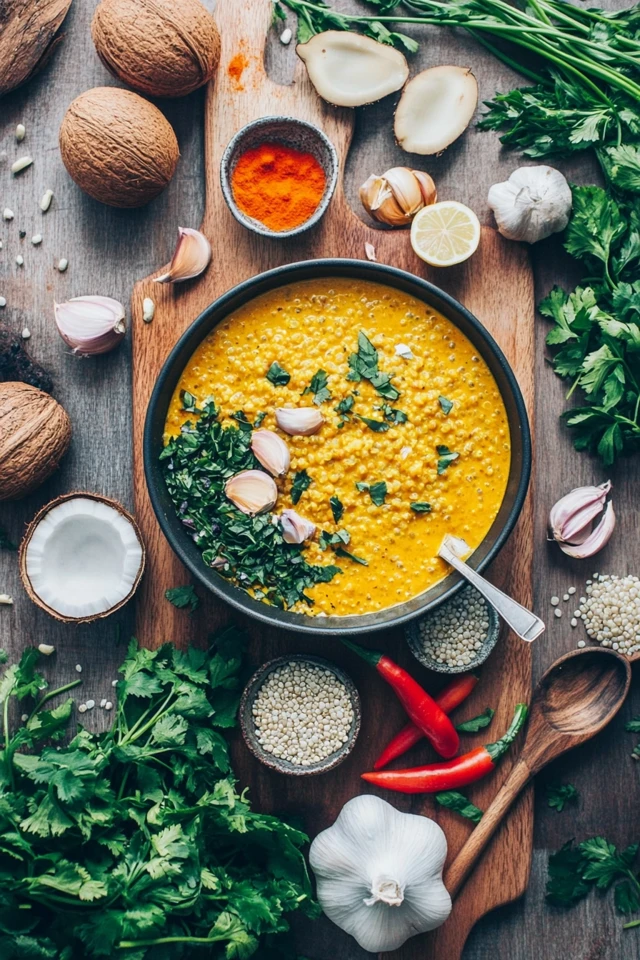
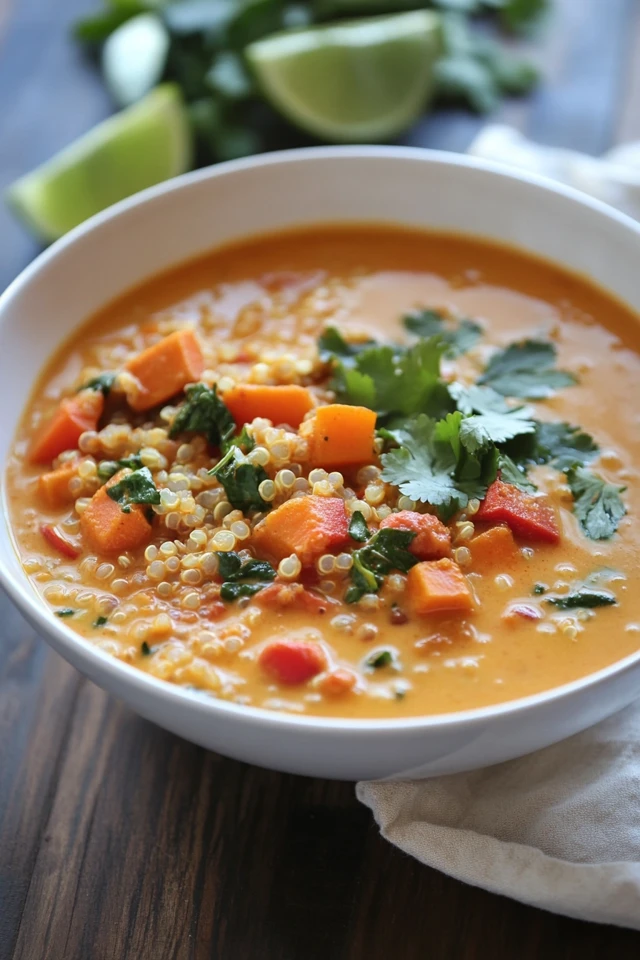
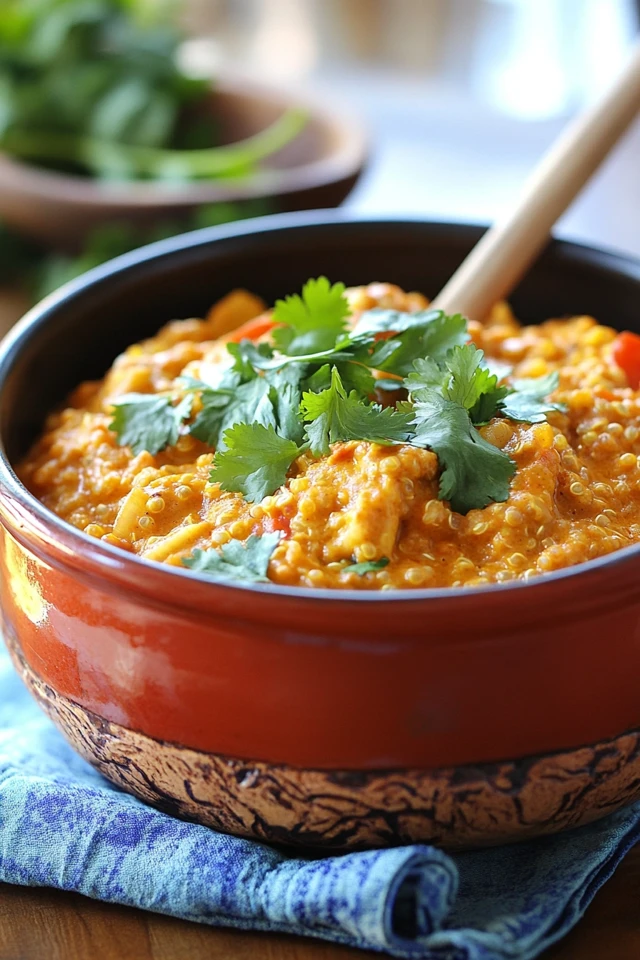
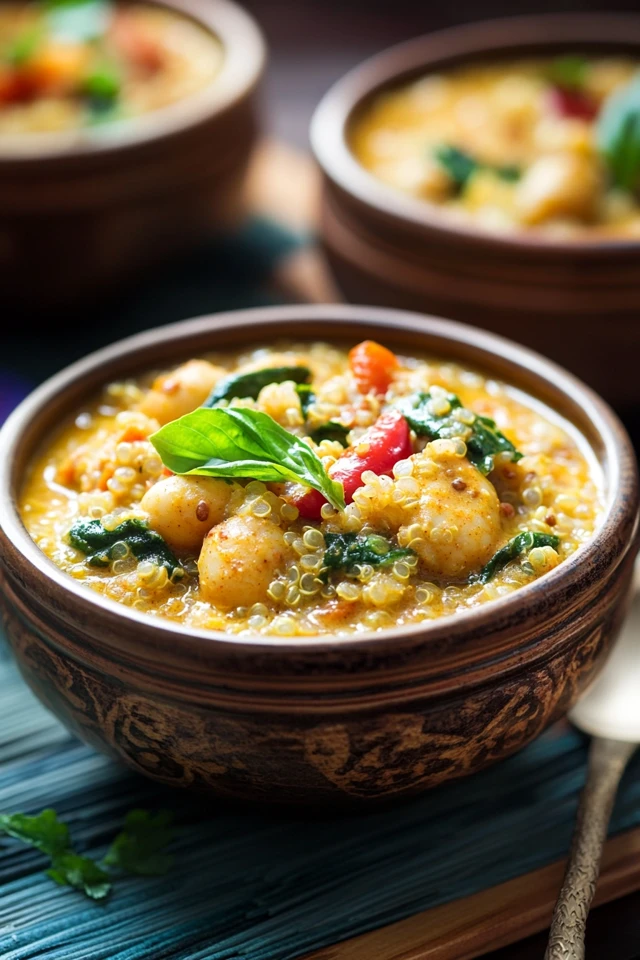
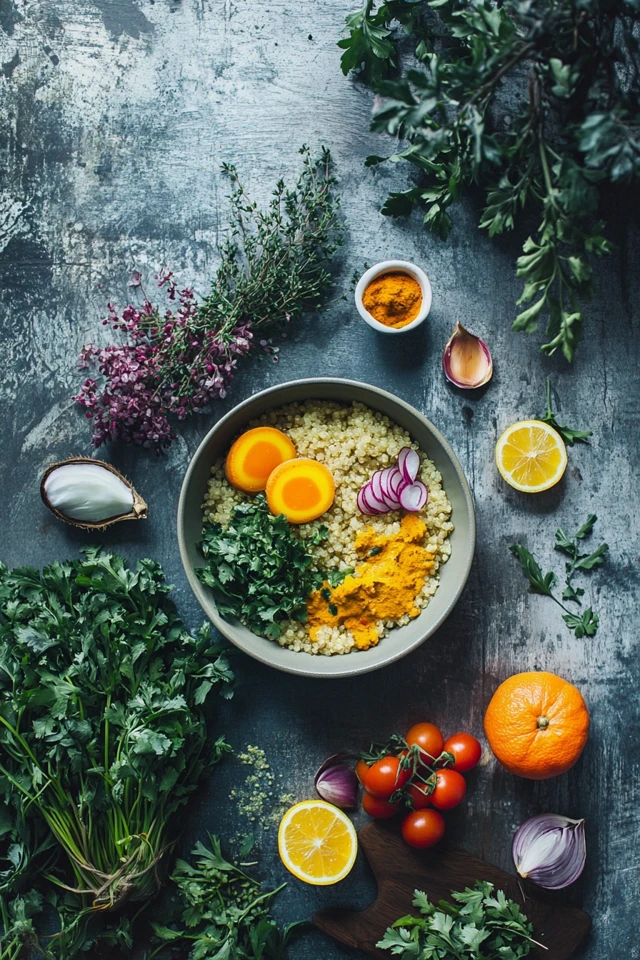
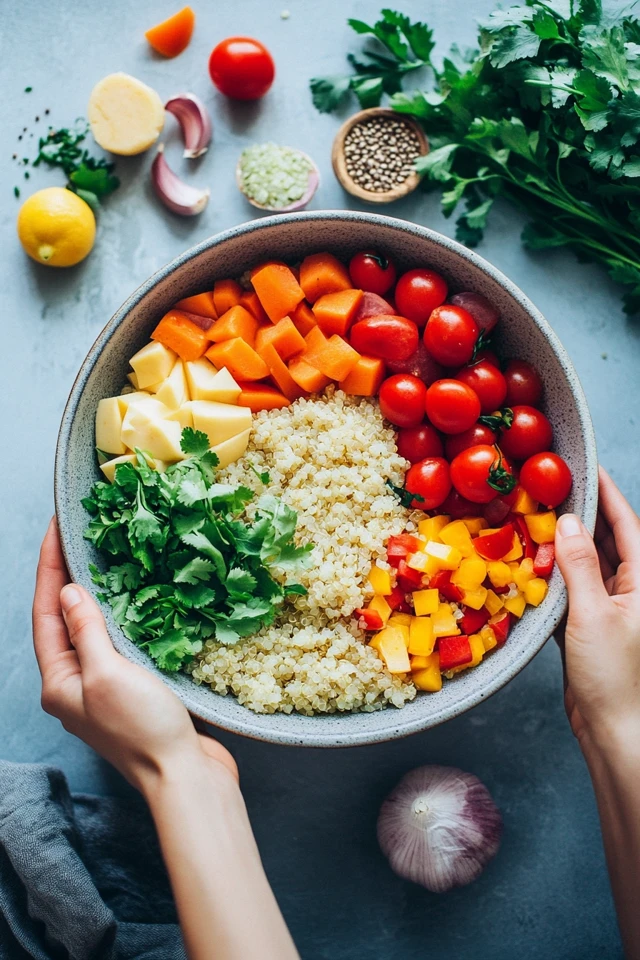
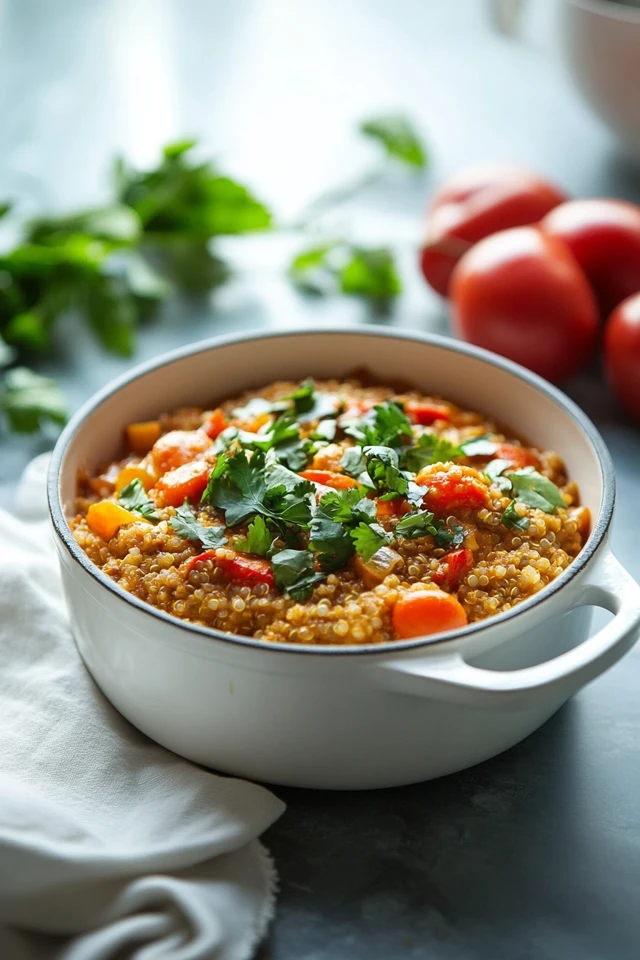
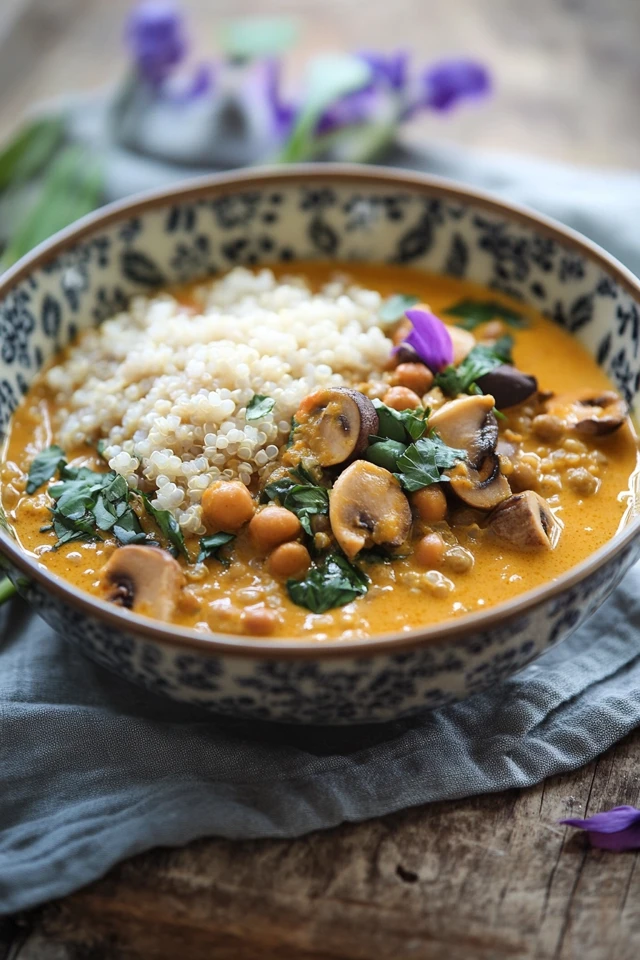
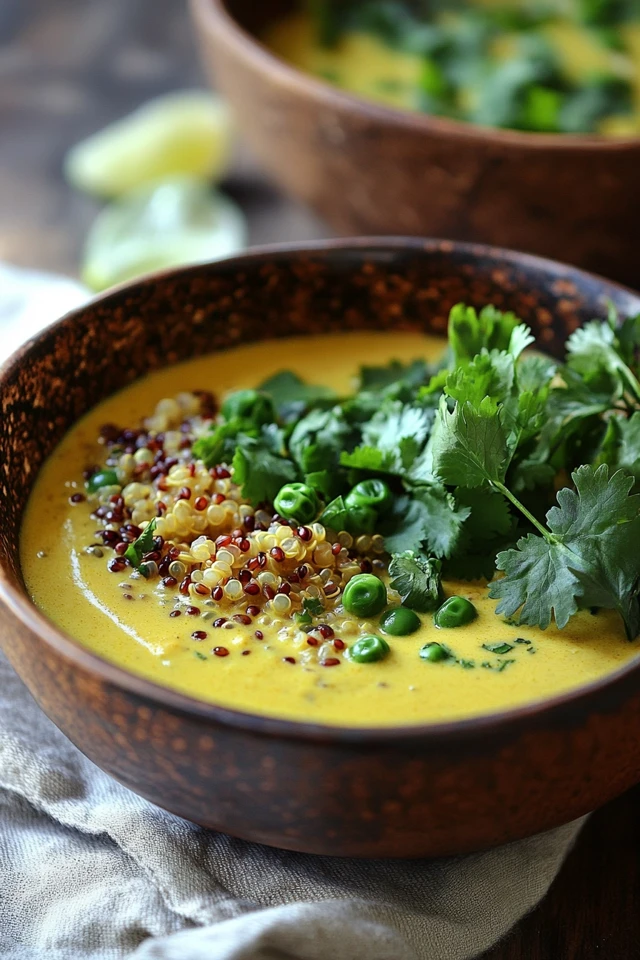
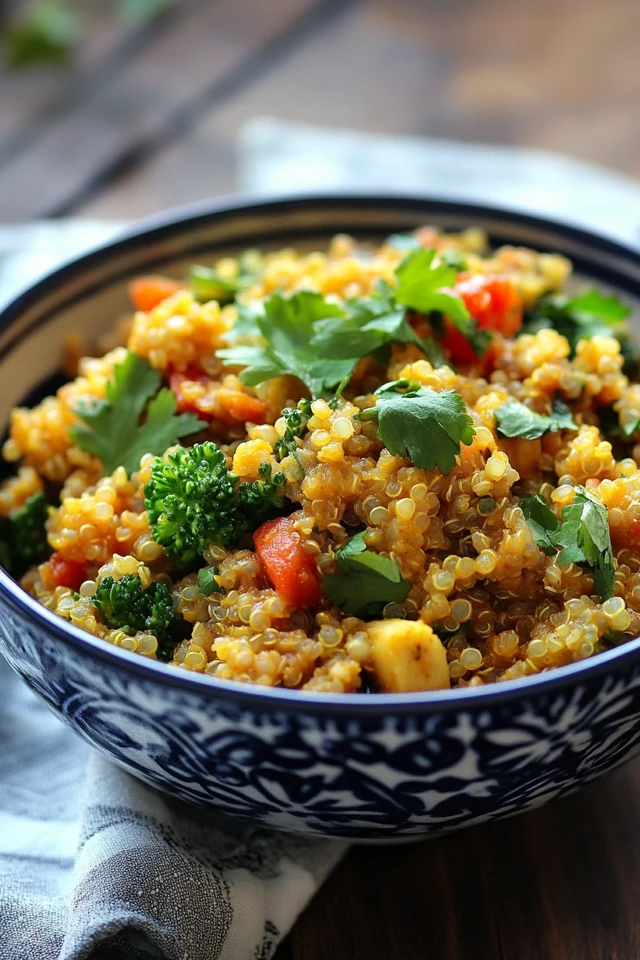
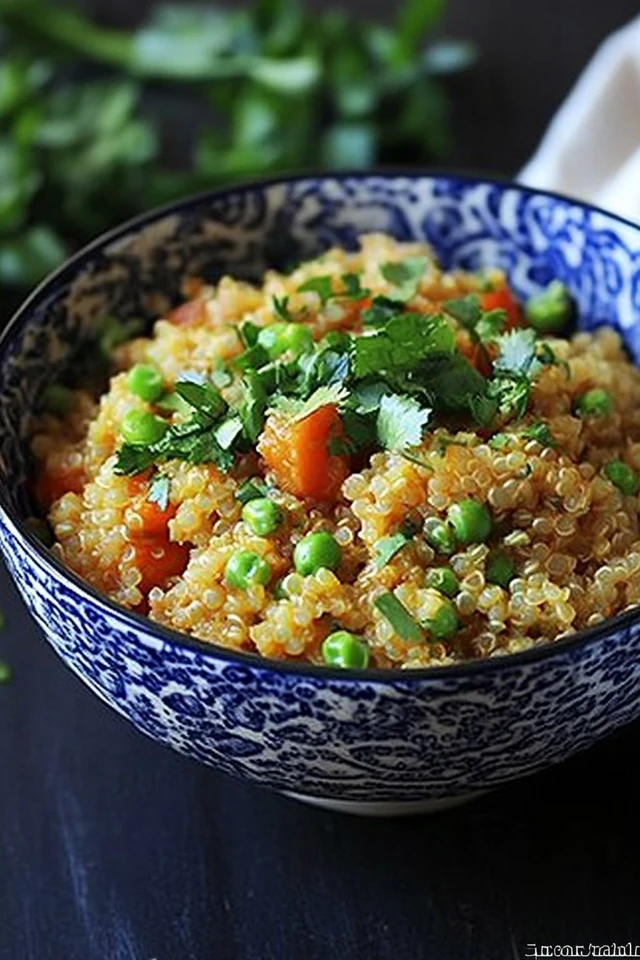
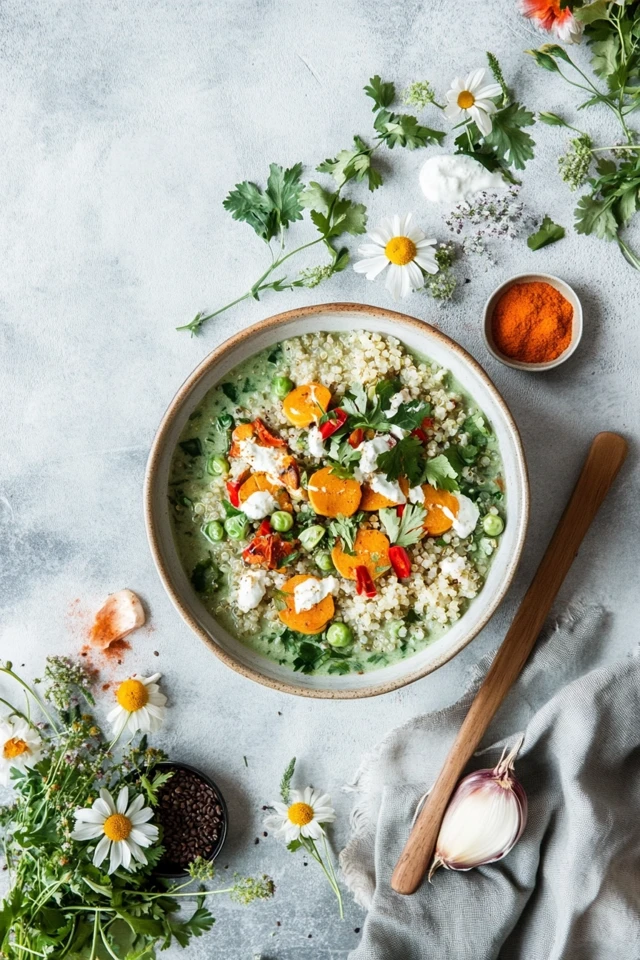
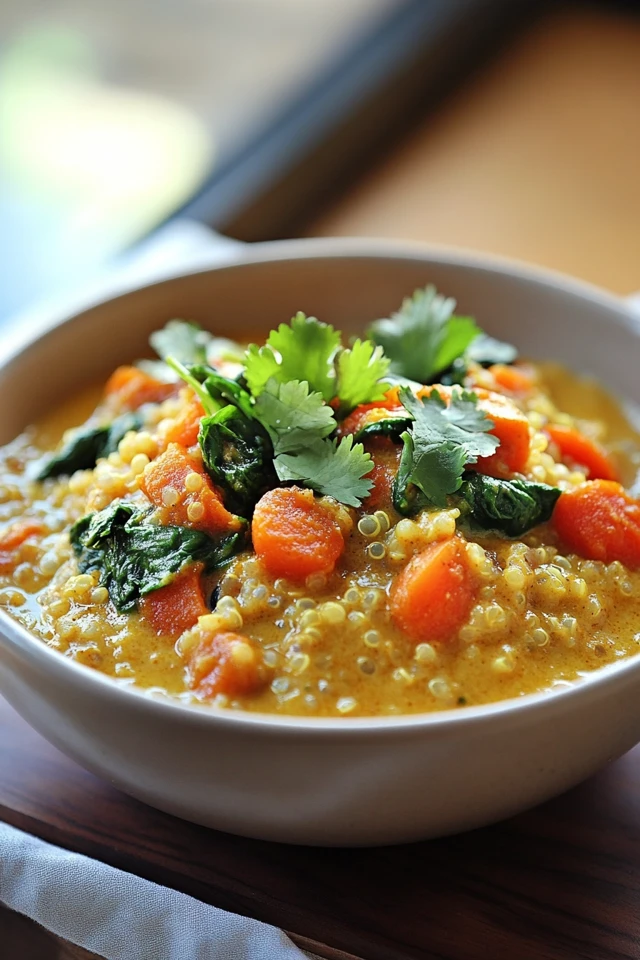
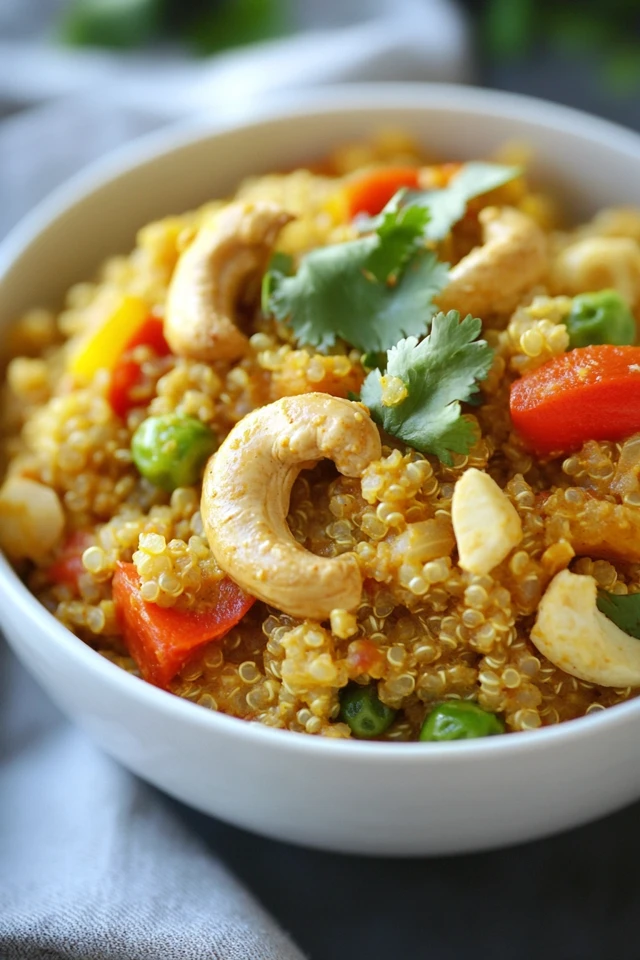
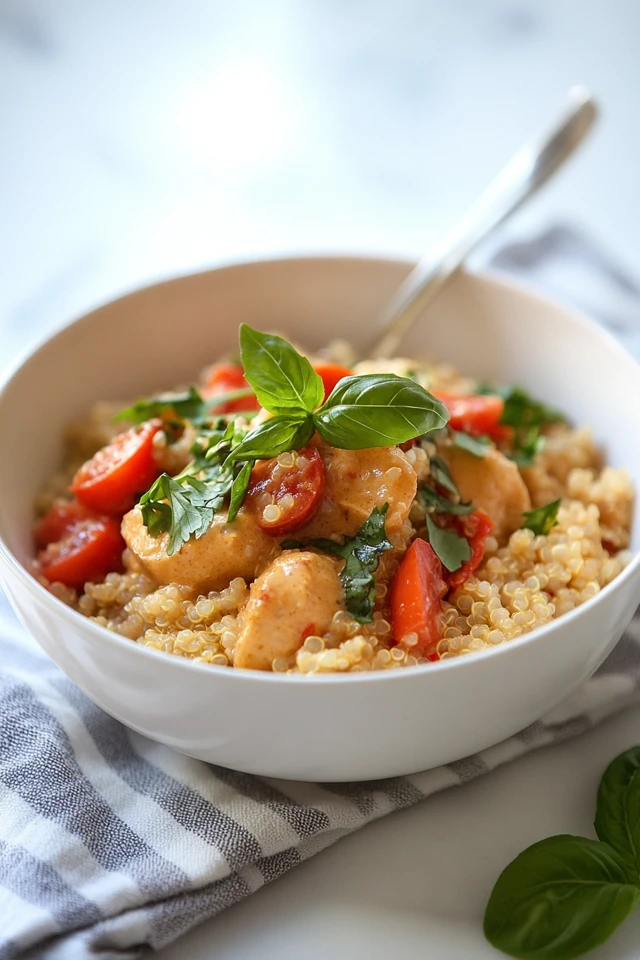
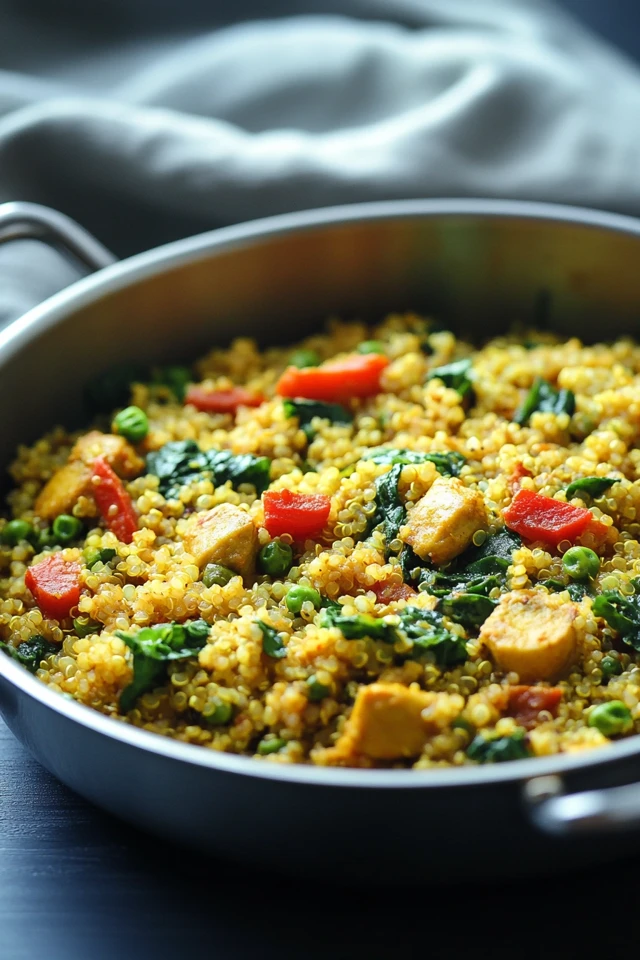
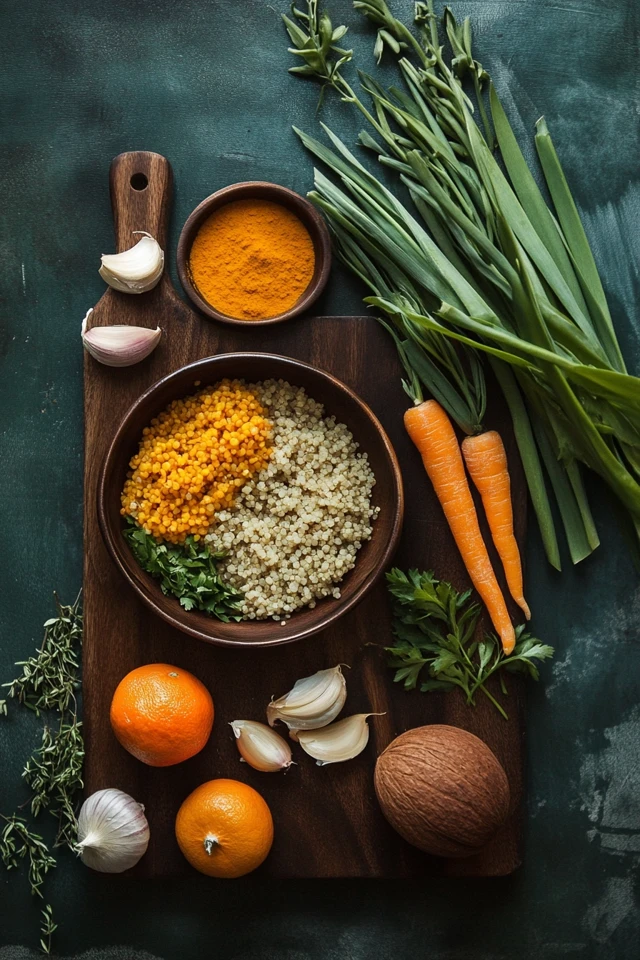
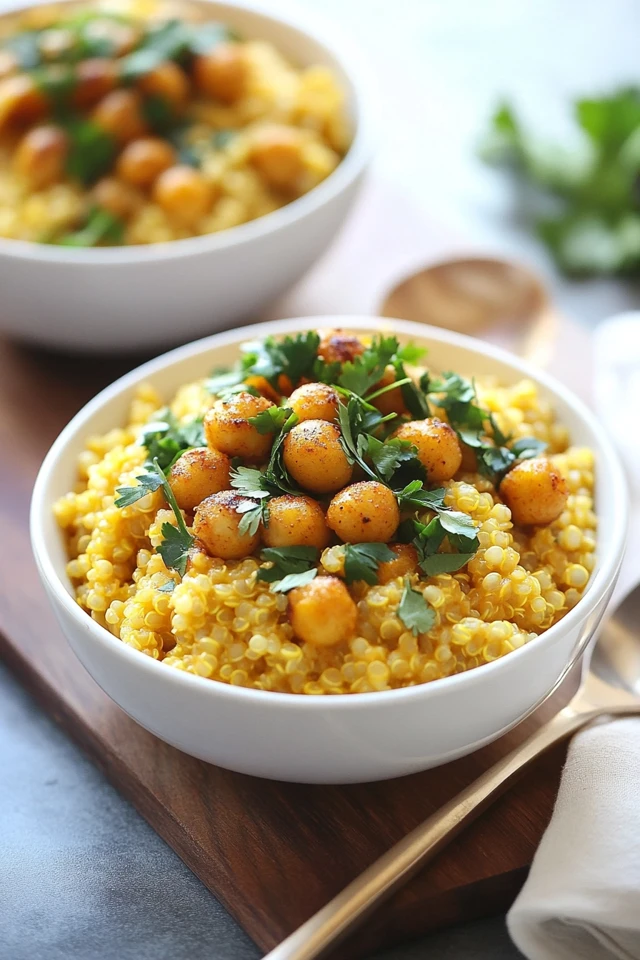
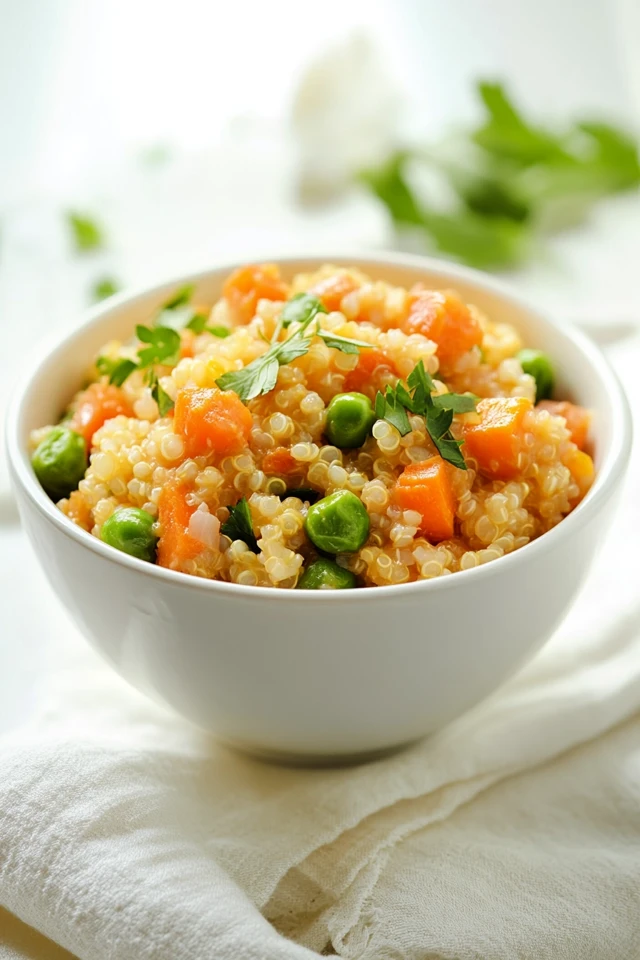
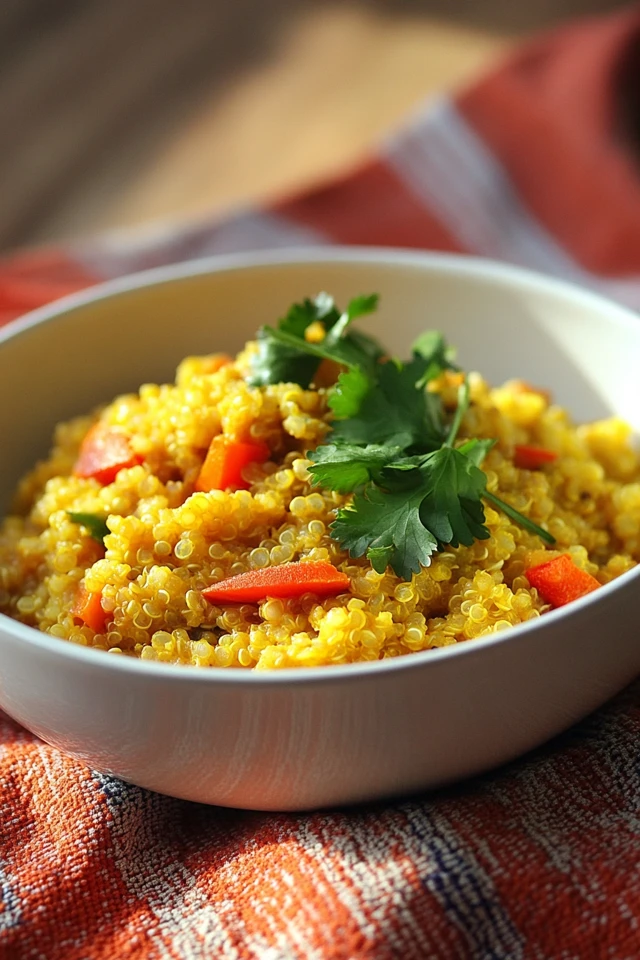
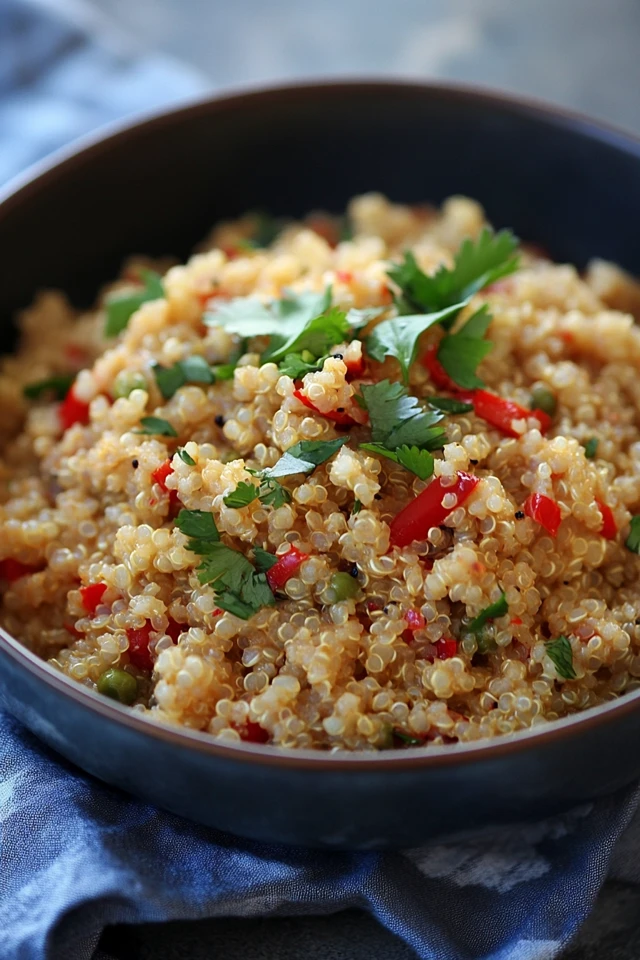
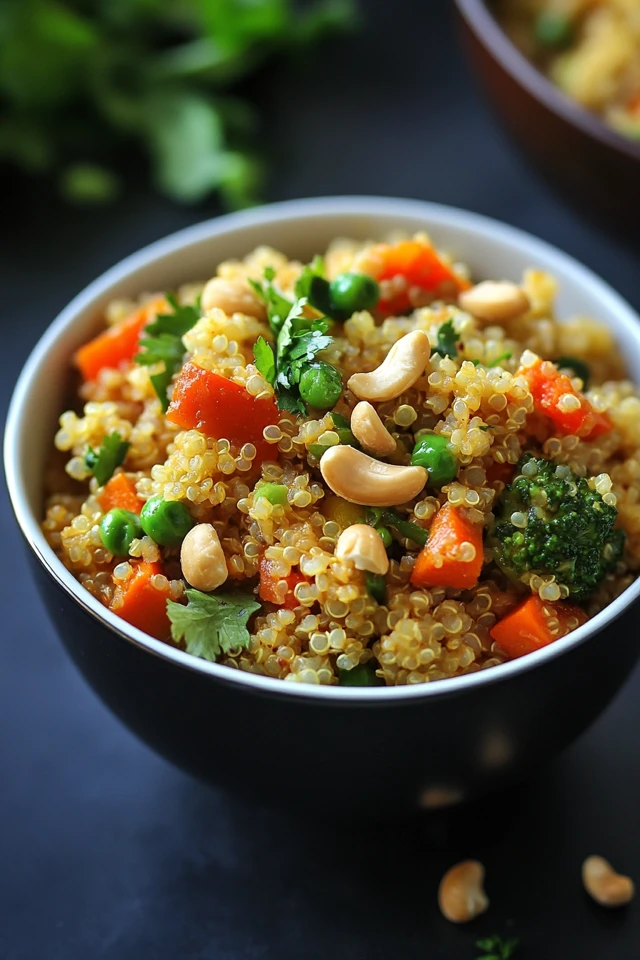
Frequently Asked Questions (FAQs)
1. Can I use different types of quinoa for this recipe?
Absolutely! While the recipe calls for standard white or red quinoa, you can substitute it with other varieties like black quinoa or tricolor quinoa for different textures and flavors. Adjust the cooking time as needed based on the type of quinoa used.
2. Is this recipe gluten-free?
Yes, this One-Pot Coconut Curry Quinoa is naturally gluten-free. To ensure it remains gluten-free, use tamari instead of soy sauce and verify that all other ingredients, such as spices and broth, are free from gluten-containing additives.
3. How can I make this dish dairy-free?
This recipe is already dairy-free as it uses coconut milk instead of dairy-based creams or milk. It’s perfect for those following a vegan or dairy-free diet.
4. Can I make this curry ahead of time?
Yes, this curry is an excellent option for meal prep. Prepare and store it in airtight containers in the refrigerator for up to 4 days. It also freezes well for up to 2 months. Reheat on the stovetop or microwave, adding a splash of water or broth to restore moisture if necessary.
5. What can I substitute if I’m allergic to coconut?
If you’re allergic to coconut or prefer not to use it, you can substitute the coconut milk with other plant-based milk alternatives such as almond milk, cashew milk, or oat milk. For added creaminess, consider using a dairy-free cream or blending soaked cashews into a smooth paste.
6. How can I reduce the sodium content in this recipe?
To lower the sodium content, opt for low-sodium vegetable broth and tamari. Additionally, you can reduce the amount of added salt and rely more on spices and fresh herbs to enhance the flavor.
7. Can I add meat substitutes to this curry?
Absolutely! You can add plant-based meat substitutes like tempeh, seitan, or vegan sausage slices to increase the protein content and add more texture to the dish. Sauté the meat substitute separately before adding it to the curry.
8. What are some other garnish options besides cilantro?
If you’re not a fan of cilantro, try garnishing with fresh parsley, green onions, or a sprinkle of nutritional yeast for a cheesy flavor. A dollop of vegan yogurt or a squeeze of lime can also add a delightful finish.
9. Is this recipe suitable for kids?
Yes, this creamy and flavorful curry is kid-friendly. To make it more appealing to children, consider reducing the spice level and incorporating their favorite vegetables. Serve it alongside their preferred grains or with a side of naan bread for a complete meal.
10. Can I use fresh curry paste instead of curry powder?
Yes, you can use fresh curry paste if you prefer. Substitute the curry powder with an equivalent amount of fresh curry paste, adjusting the quantity based on your taste preferences. Keep in mind that fresh curry paste may add different flavor nuances to the dish.
About the Author
Welcome to Vegan & Plant-Based Kitchen! I’m Julio Arco, a passionate vegan chef dedicated to creating delicious, easy-to-make plant-based recipes that nourish both body and soul. Since embracing a vegan lifestyle in 2010, I’ve been on a culinary journey to explore the endless possibilities of plant-based cooking. From vibrant stir-fries to indulgent desserts, my mission is to inspire and empower you to embrace a compassionate and healthy lifestyle through wholesome food.
Join me on this journey as we explore diverse flavors, experiment with fresh ingredients, and celebrate the beauty of plant-based living. Let’s create, share, and enjoy the goodness of vegan cooking together!
Disclaimer: This blog post is intended for informational purposes only. Always consult with a healthcare professional before making significant changes to your diet.

